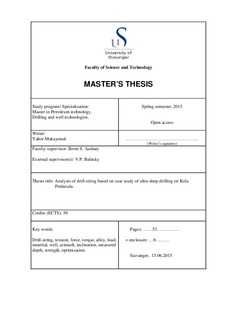| dc.contributor.author | Makayonak, Yahor | |
| dc.date.accessioned | 2015-09-21T07:59:57Z | |
| dc.date.available | 2015-09-21T07:59:57Z | |
| dc.date.issued | 2015-06 | |
| dc.identifier.uri | http://hdl.handle.net/11250/300808 | |
| dc.description | Master's thesis in Petroleum engineering | nb_NO |
| dc.description.abstract | The topic of the following project is devoted to the theme of drilling of the ultra-deep wells and in particular to the optimization of the length of dual aluminum-steel drill string as a one of the concept which have been used for drilling of super deep well on Kolskyi peninsula.
The mentioned project is the most prominent and successful representative of conducted in formal Soviet Union countries (FSU) program of super-deep scientific drilling in 70th-90th years of the last century. The program of super-deep borehole construction was in many senses a unique long-term field experiment. Several new drilling technologies have been developed at this time. Among them aluminum drill-pipes, gear reduction turbo-drills, coring tools for hard rock drilling, drilling and coring without pulling the drill-pipes (DWPP) in crystalline rocks, vertical drilling technology and a number of other improvements.
Interest of scientists to the composition and structure of the deep zones of the crust is inexhaustible and is always on the agenda. But the possibility of getting the unique scientific and technological data is limited to the actual level of scientific and technical progress. Modern simulators and software products together with experience based engineering approach allows us to consider in more detail the calculation of loads on the drill string and take into account a number of relevant factors. A suchlike working mechanism was not available to engineers thirty years ago and the work was generally based on intuitive knowledge and experience of the scientists and engineering community.
Outcome of the conducted project on Kolskyi peninsula was outstanding not only as a result for geological and geophysical areas, but also as an outcome in commercial drilling engineering. It gave an impulse for the further drilling technology development and played the role in the oil and gas drilling technology upgrading. Important to notice, that aluminium high strength drill-pipes was developed at this time and found successful application in offshore riser-less drilling. Aluminium drill-strings become a source of increased interest in the last decade mainly because of the hidden potentials for extended reach and horizontal drilling applications and improved drill rig capacity.
The issue of drilling of ultra-deep wells will increase in the future also due to normal growing interest of engineering community to drill an unreachable depth and to gain new high technological results. The topic may be of interest also for the wide range of companies involved in the development of reservoirs with extended reach depth. | nb_NO |
| dc.language.iso | eng | nb_NO |
| dc.publisher | University of Stavanger, Norway | nb_NO |
| dc.relation.ispartofseries | Masteroppgave/UIS-TN-IPT/2015; | |
| dc.rights | CC0 1.0 Universal | * |
| dc.rights.uri | http://creativecommons.org/publicdomain/zero/1.0/ | * |
| dc.subject | petroleumsteknologi | nb_NO |
| dc.subject | petroleum engineering | nb_NO |
| dc.subject | ultra-deep drilling | nb_NO |
| dc.subject | drilling technology | nb_NO |
| dc.subject | boreteknologi | nb_NO |
| dc.subject | Kolskyi | nb_NO |
| dc.title | Analysis of drill-string based on case study of ultra-deep drilling on Kola Peninsula. | nb_NO |
| dc.type | Master thesis | nb_NO |
| dc.subject.nsi | VDP::Technology: 500::Rock and petroleum disciplines: 510::Petroleum engineering: 512 | nb_NO |
| dc.source.pagenumber | 53 | nb_NO |

